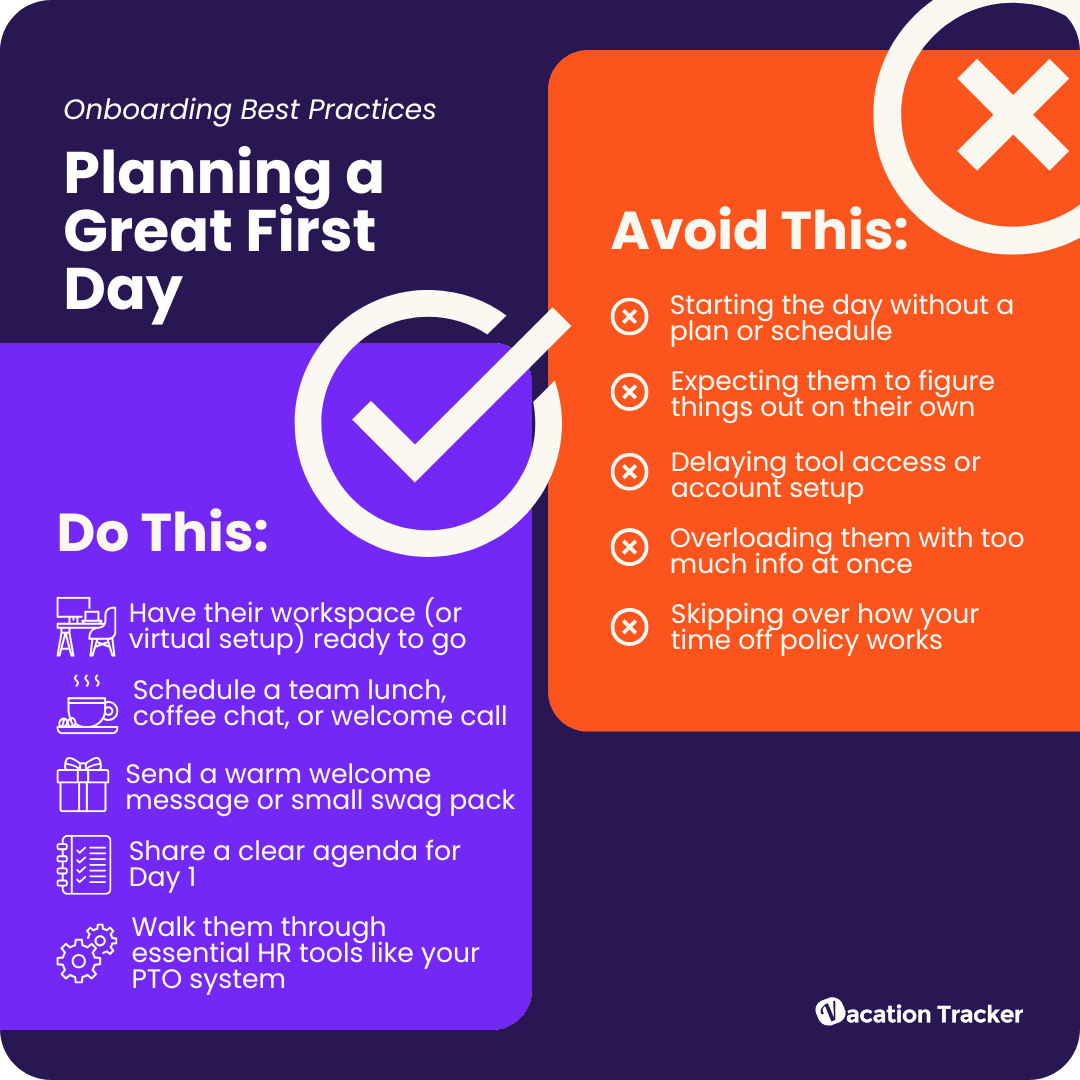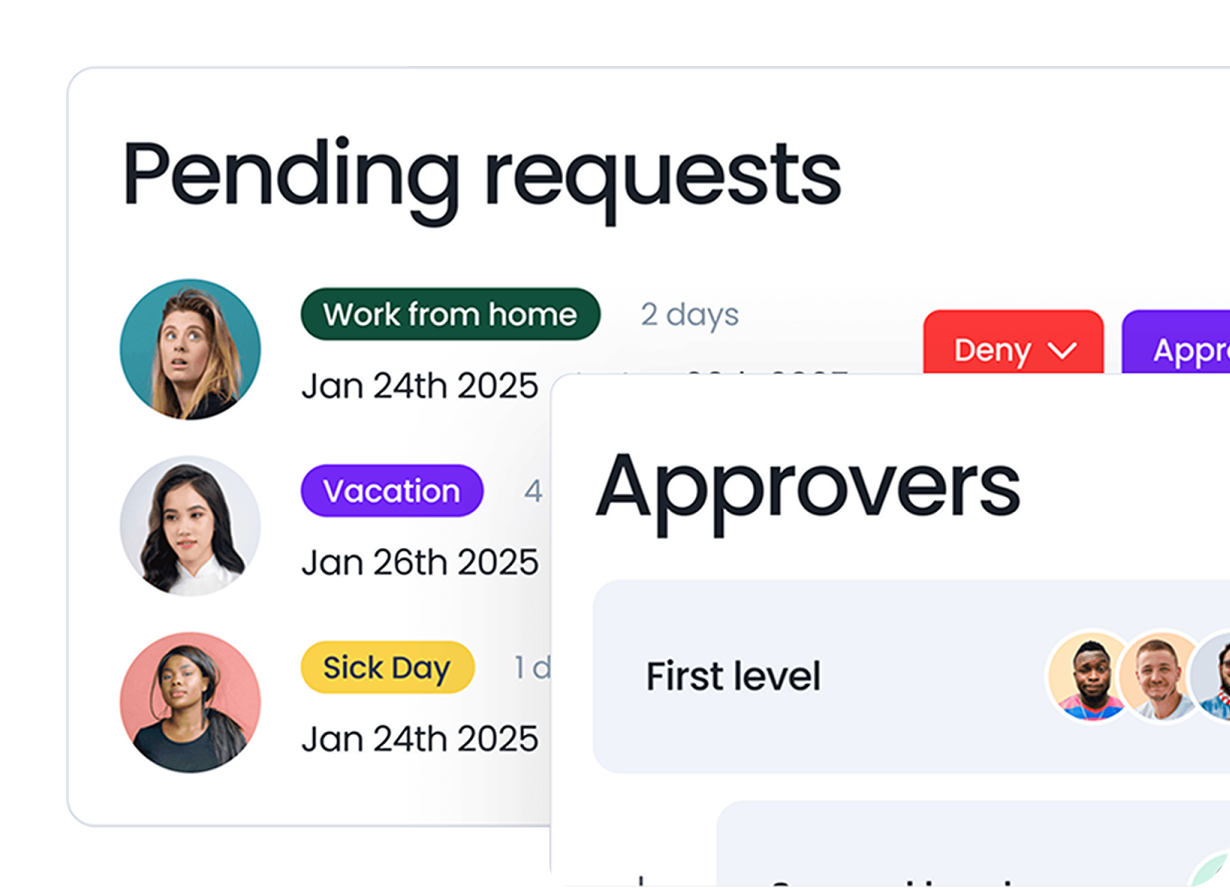Last updated on May 7, 2025
A new hire is kind of like a new relationship. Hear me out.
If all goes well in the first few days, sparks fly. But a bad first impression could cause things to turn sour, fast.
No pressure.
That’s why we put together this list of onboarding best practices, to help you get it right from day one. Ready to make your onboarding process smoother, more efficient, and downright enjoyable for everyone involved? Let’s go!
The Importance of Onboarding for New Hires
Why invest time in structured onboarding?
It's simple: A great onboarding experience pays off.
Research shows that a strong onboarding process can improve new hire retention by 82% and boost productivity by over 70%, meaning employees stick around longer and work faster.
On the flip side, poor onboarding has serious consequences. New employee turnover can be alarmingly high, as many as one in five new hires leave within the first 45 days if they feel neglected or overwhelmed.
Yet, many companies fall short: only 12% of employees strongly feel their organization onboards well. That means the majority of workplaces have room to improve. The good news is that by following onboarding best practices, you can dramatically increase a new hire’s confidence and loyalty from day one. Don’t worry, we’ll show you how!
Setting the Stage for Success
As you know, first impressions matter. Onboarding doesn’t begin on a new hire’s first day at 9 AM. No, it starts the moment they accept your offer. Setting the stage for success means getting a head start on welcoming your new team member and ensuring their initial days are positive and productive.
Creating a Positive First Impression
Imagine walking into a new job and immediately feeling like you belong there.
That’s the goal of a positive first impression in onboarding.
To achieve this, start by engaging new hires even before day one. For example, send a warm welcome email after they sign the offer, or mail them a small welcome kit with company swag or a personal note from the team. This kind of “pre-boarding” keeps the excitement high during any waiting period and shows the new hire that you’re prepared and excited for their arrival.
On the new hire’s first day, go the extra mile to make them feel welcome. Have their workstation or tools set up and ready. Introduce them to the team and maybe schedule a team lunch or a morning coffee chat so they can start forming personal connections right away. These gestures might seem small, but they leave a big impression.
Remember, first-day experiences can make or break a new hire’s outlook. With a supportive welcome, they’re far more likely to think, “I made the right choice joining this team.” But, if they feel ignored or lost on Day 1, doubt can creep in quickly.
Setting Clear Expectations Early
Along with feeling welcome, new hires crave clarity. Early in the onboarding process, take time to spell out expectations for the role and what success looks like in the first weeks and months. Sit down with your new team member to go over their job responsibilities, initial projects, and goals.
It’s equally important to communicate sbasic workplace standards and expectations. Explain working hours, communication channels, and any “unwritten rules” that seasoned employees might take for granted. Clear expectations prevent misunderstandings and help new hires integrate smoothly into the workflow.
Keep in mind that expectation-setting is a two-way street. Encourage the new hire to voice their own expectations and ask questions. Create an open dialogue so they feel safe bringing up concerns. By aligning on expectations early, you avoid surprises down the line. The new hire will appreciate knowing what’s ahead, and you’ll benefit from their increased confidence and focus.
Optimizing the Onboarding Process
Onboarding involves a lot of moving parts, from paperwork to training to integrating the person into the team. A smooth onboarding frees up time from mundane tasks so you can focus on what truly matters: setting your new hire up for success.
Providing Training and Resources
Effective training is the foundation of successful onboarding. Your new hire will have a learning curve, no matter how experienced they are, because every organization does things a little differently.
Plan a training program that equips them with the knowledge and skills they need on day one. But be careful not to overwhelm them on their first day either. Start with the basics and build up gradually.
For example, many companies schedule an orientation session in the first week to cover company culture, policies, and an overview of each department. Then, role-specific training can be spread over the first few weeks.
Throughout the training phase, encourage questions. A new hire might fear looking inexperienced, so actively create a safe space for curiosity. Remind them that you don’t expect them to know everything right away.
Pro tip: Providing a “cheat sheet” of key contacts or an FAQ for common newbie questions can also empower them to find answers independently. When new employees have ample resources at their fingertips, they ramp up faster and feel more self-sufficient in their first weeks.
Building a Supportive Work Environment
Starting a new job can feel intimidating, so one of the best onboarding best practices is to surround new hires with support. This means fostering connections and ensuring no new hire feels isolated as they learn the ropes.
A simple but powerful way to do this is through a buddy or mentor system. Pair the new employee with a friendly, experienced team member who can show them around, introduce them to others, and be their go-to for any questions that pop up.
Did you know? More than half of new hires said having an onboarding buddy or mentor was one of the most important factors in getting up to speed quickly. A buddy offers guidance on day-to-day stuff that might not be covered in formal training, like “Here’s how to book a meeting room” or “We usually all grab coffee at 3 PM, join us!”. Plus, it gives the new hire an immediate friend to turn to, which can reduce first-week jitters.
Managers also play an essential role in creating a supportive atmosphere. It’s hiring manager or team leader should be accessible and actively involved in the onboarding. A quick check-in at the end of the first day or at the end of the first week can reassure the new hire that you’re invested in their success.
Creating social opportunities is another best practice. This could mean scheduling team lunches, virtual coffee chats for remote hires, or after-work gatherings. Even a small welcome celebration or a team Zoom call to introduce a remote employee can make a big difference. Little touches like this prevent new hires from feeling isolated. They also signal your team’s culture of inclusion.
Leave Management During Onboarding
One often overlooked aspect of onboarding is explaining how PTO works within your organization. Vacation and sick days might not be the first thing on a manager’s mind when a new person joins, but clearly outlining your leave policies from the get-go helps avoid confusion and frustration down the line.
The Importance of Efficient Leave Tracking
Think about the questions a new hire might have regarding time off:
“How much time off do I have?”
“When am I allowed to take vacation?”
“How do I ask for time off?”
These are all valid concerns, and addressing them early is key.
The onboarding phase should include an overview of how your company’s leave management works. If you have an employee handbook or orientation session, dedicate a portion of it to explaining PTO, sick leave, holidays, and any other relevant leave types.
Clarify any probationary period rules that prohibit them from taking time off during their first few months on the job. Being upfront about these policies prevents misunderstandings. The last thing you want is a new hire planning a week off only to be told that they aren’t actually eligible for time off yet. Oh dear.
Efficient leave tracking from day one also protects the company and the employee in terms of fairness and compliance. By setting the new hire up in your leave management system right away, you ensure their accruals are calculated correctly and any leave they take (or plan to take) is properly logged. This avoids headaches later like discovering an employee wasn’t accruing PTO for months due to a setup error.
Manual tracking makes it way too easy to mess up a new hire’s leave balance—or anyone’s, really. One wrong formula, and suddenly someone’s missing a vacation day they’ve earned.
That’s where a tool like Vacation Tracker comes in. It handles all the calculations behind the scenes and gives everyone a clear view of their time off. With a shared calendar, scheduled reminders, and full visibility across the board, teams trust that everything is being handled fairly and accurately.
And of course, it also saves your HR team time, freeing them to focus on the more human side of onboarding rather than number-crunching days off.
Key Features to Simplify Leave Management
Managing leave for new team members doesn’t have to be a manual, error-prone process. Modern PTO tracking tools come with features that specifically address onboarding scenarios, making life easier for HR and ensuring new hires are set up correctly.
Vacation Tracker, for example, offers several handy features that simplify leave management during onboarding.
Probation Periods
Admins can configure a probation period for new employees to automatically reject leave requests made within a certain number of days. If new hires request leave during this time, they will be automatically rejected with a customizable message that reaffirms your policy. This removes the awkwardness of having to remind someone they can’t take leave yet and makes sure the rules are clear from day one.
Accruals
Vacation Tracker automates PTO accrual calculations. From the moment a new hire joins, the system will begin tallying their earned leave according to your policy.
That means if you offer 15 days of vacation per year, a new hire will see their PTO bank grow proportionally each pay period or month. Employees can trust that their vacation balance is accurate, and HR doesn’t need to lift a finger or worry about miscalculating anything.
Prorating Leave Entitlements
When someone joins mid-year, figuring out their pro-rated leave entitlement can be tricky. Vacation Tracker handles prorating automatically.
If your fiscal year reset is in January and you hire someone in July, the system can allocate them half the annual leave allowance (or whatever fraction is appropriate). Employees get a fair amount of time off, not too much or too little.
![]()
By leveraging these features, you take a huge weight off the admin side of onboarding. New hires will appreciate the clarity they gain by seeing their leave policy in action and trust that they’re getting what they’re entitled to. Meanwhile, managers and HR can rest easy knowing the system is enforcing probation rules, calculating accruals, and keeping balances accurate. Everyone’s a winner!
Continuous Support and Feedback
Onboarding doesn’t end after the first week or even the first month. The best companies recognize that supporting employees is an ongoing process. In this final section of our onboarding best practices, we’ll look at keeping the momentum going beyond the initial orientation period.
The Role of Regular Check-Ins
It’s easy to place all your attention on helping the employees adjust in week one and then assume they’re fine and let them be. But consider this: after the initial training, real work begins, and that’s when new challenges or questions can arise for your hire. Setting up regular check-ins helps catch any issues early and reinforces to the employee that you’re invested in their growth.
What do these check-ins look like?
They can be informal or formal, depending on your style and company culture. A team leader might schedule a 15-minute coffee chat at the end of the first week, then another at one month, three months, and so on.
During these meetings, ask open-ended questions that invite them to speak candidly about their experience. It’s also a good time to offer encouragement and acknowledge wins like completing a training module or successfully finishing their first project task.
Regular check-ins are especially crucial if you’ve got remote or hybrid employees. Without face-to-face office interactions, a remote new hire might feel “out of sight, out of mind.”
Proactively scheduling video calls to touch base can prevent them from feeling disconnected. Consistent communication can significantly boost the new hire’s confidence and engagement.
Offering Ongoing Feedback and Improvement
Feedback during onboarding shouldn’t be a one-way street. Of course, as a manager or team lead, you’ll be giving feedback to your new hire; that’s how they learn and improve. But equally important is receiving feedback about how the onboarding experience is going. The best onboarding programs treat the first few months as a learning period, not just for the employee, but for the organization as well.
First, let’s talk about giving feedback. New employees typically crave guidance. They want to know if they’re doing things right or if they should adjust their approach. Make it a habit to share constructive feedback regularly in those early days. This doesn’t mean micromanaging or criticizing every move; it means highlighting wins and gently correcting course where needed.
Now, the flip side: ask the new hire for their feedback about the onboarding process. How do they feel about their training? Do they have all the resources they need? Was there something they expected that didn’t happen? New hires often have a fresh perspective that can reveal gaps in your onboarding.
By continuously supporting your employees’ development and seeking their input, you ensure they keep advancing and feeling positive about their growth.

Recap
So, what have we learned today?
The first few days matter. A lot.
You can’t fake a strong start, and you don’t usually get a second chance to make someone feel like they belong.
That’s what onboarding is really about: turning that “yes” into something long-term.
By putting thought into your process. mapping out expectations, offering the right tools, and showing up with real support, you’re not just filling out forms. Instead, you’re building trust. You’re setting your new hire up to thrive.
Now that you’ve got the strategy, it’s time to back it up with the right tools.
Book a demo of Vacation Tracker and see how smart leave management can take one more thing off your plate and help every new hire start strong, stay informed, and feel like part of the team from day one.
Learn how to manage time off without
Tracking Can Be
confusion, delays, or admin headaches. 

Claudia
Claudia is an experienced marketer with a passion for writing and creating engaging content that connects with readers.




